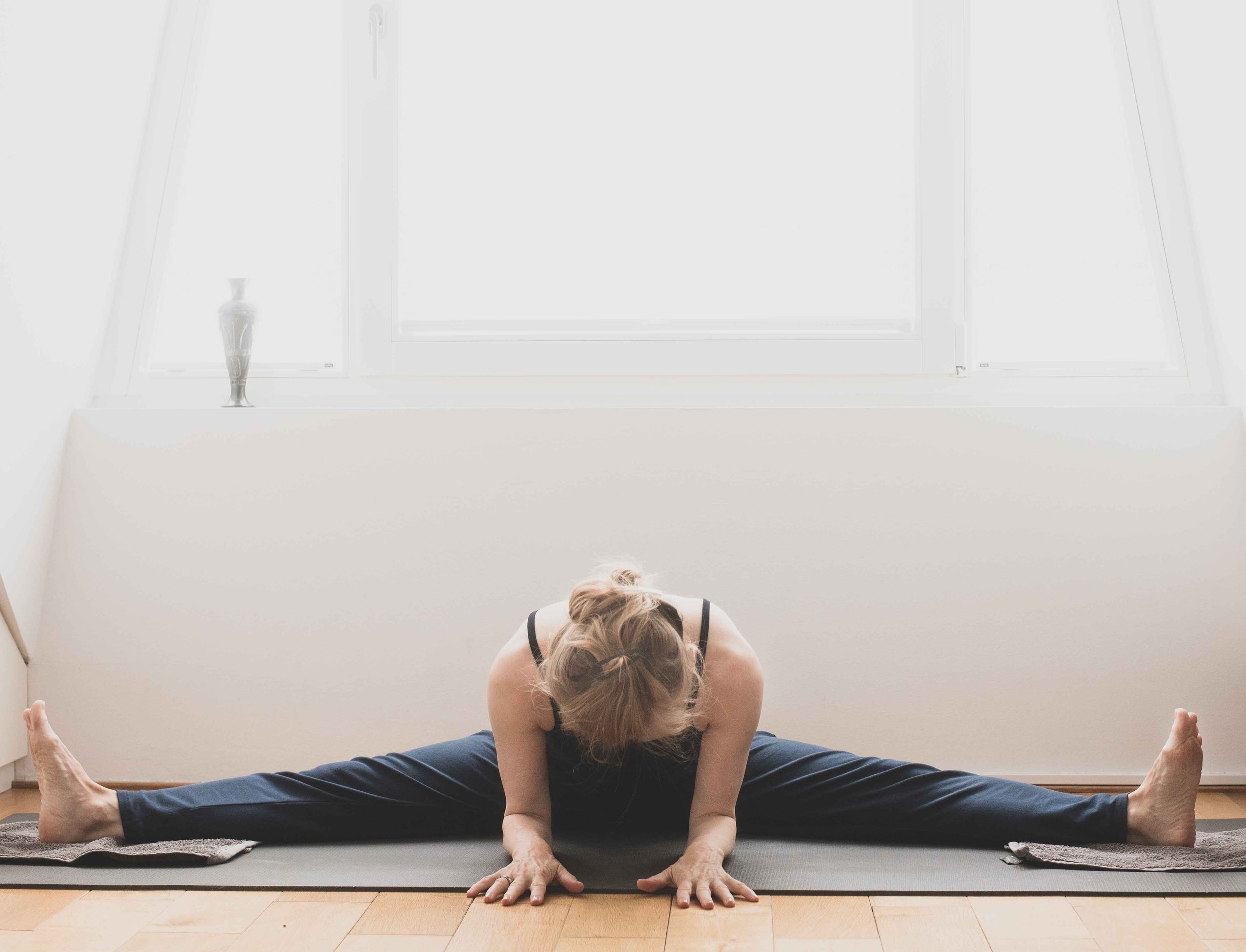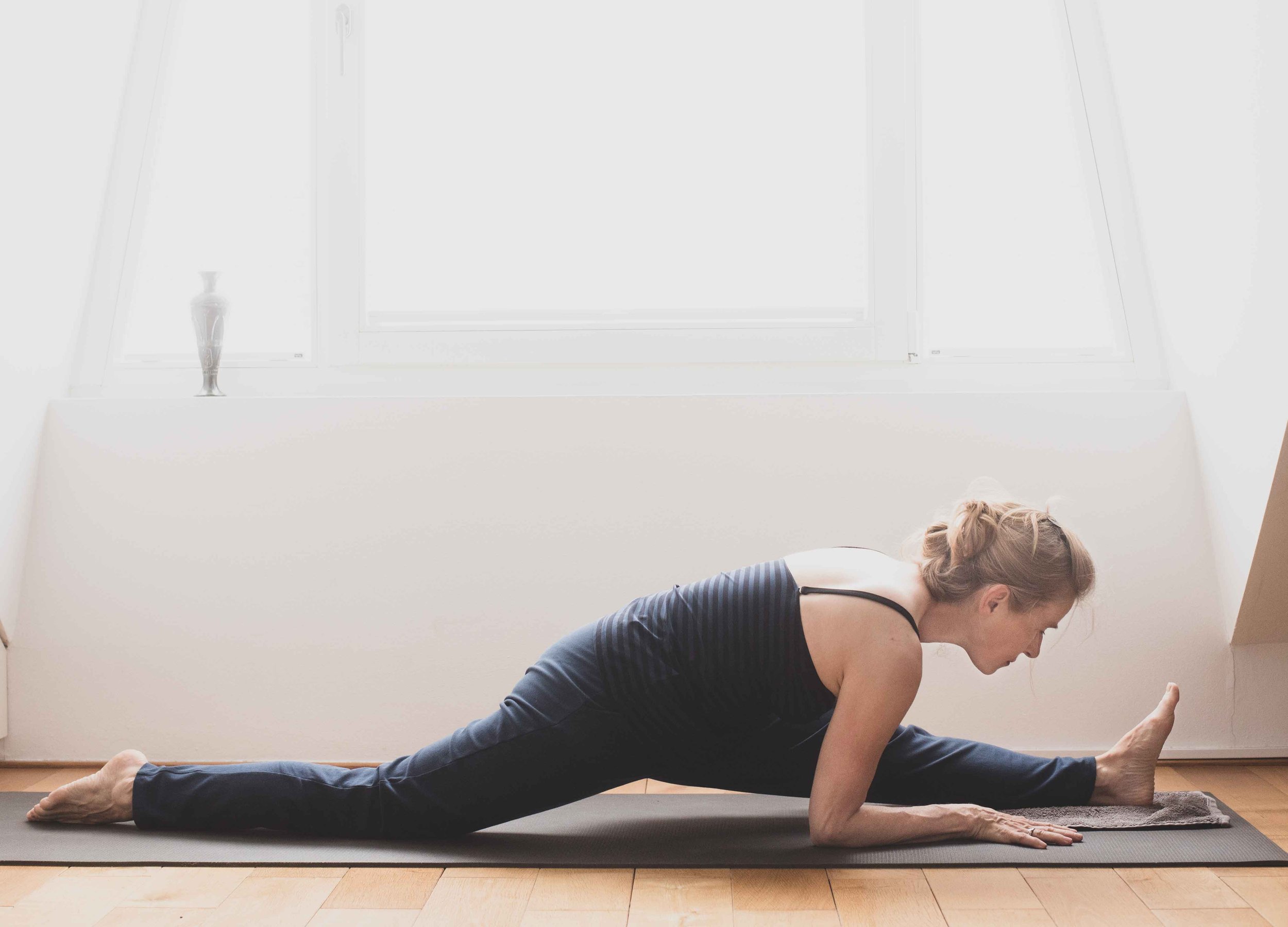Summary splits
For over 12 weeks I focused on learning the splits, both forward and to the side. I have gotten much better during these months. My understanding of the positions has increased. The splits are far from mastered. The process and the insights are just as important as executing a perfect position.
My insights:
1. when you practice the opportunity is there to get better. However, this does not necessarily have to happen. One can practice ineffectively or injure oneself, then the opposite of progress happens. But the opportunity is there.
2. if one does not practice, however, then one does not keep the level that one has already reached, but one becomes worse.
3. practicing is important, but understanding the positions is also important.
3.1 In hanumanasana (forward split) the hamstrings are stretched, but also the front hip muscles. You can stretch these in isolation. When performing the pose, it is important to keep in mind that the hips should remain parallel.
3.2 The most important insight in Samakonasana is that one must make a hollow back. The skeleton does not allow the legs to extend to the side without being in a hollow back.
What is the next step?
I will continue to incorporate exercises on splits into my practice. However, it will no longer be the absolute focus. The next focus will be backbends. At the end of the year I will take pictures of the splits to see how far I have come. Both positions are feasible.
Two events have slowed down my progress:
- First, I have been traveling. Then it is always difficult to practice. It is certainly possible to practice while traveling. Eliminating these interruptions would be a huge step forward.
- Unfortunately, I have also injured myself. I go to strength training regularly. There I also practice the adductors. The machine stretches the legs out to the side. With the force of the adductors, you have to squeeze the machine parts together. I had the parts swinging too far outward to have an intense stretch as well. This was probably too intense. Unfortunately, you always notice only the day after whether you have exceeded the limits too far. It will always be the case that you hurt yourself sometimes. It is a fine line between a healthy overstepping of the boundaries and being too far gone.
Hanumanasana and Samakonasana are possible I'll keep at it.
Benefits of the splits
Dynamic and static side split, April 2023
A few years ago, I had several appointments with a physical therapist. In the waiting room, I met a middle-aged woman who looked pretty beat up. I asked her if I could ask her what was wrong. Most of the time we like to talk about what's on our minds. According to her, the woman was relatively athletic. She jogged a lot. At Christmas, she went grocery shopping. In the vegetable department there was a spring onion on the floor on which she slipped. Involuntarily, she went into a straddle. Her hip broke so badly that she was asked if she could be operated on in the university hospital in front of students. She agreed to it. But even after the operation she could walk only with pain. Now physiotherapy should help.
I thought to myself that this would not have happened to me.
Many runners (track and field athletes) or people who focus on strength training don't stretch enough.
Especially in accidents, a stretched body can prevent broken bones.
And what does B.K.S. Iyengar say? His book is still on my desk.
I quote from B.K.S. Iyengar's book 'Light on Yoga', page 218:
Effects (of sanakonasana, note from me):
In this pose the hip joints are worked and the legs learn to move freely in all directions. The spine is stretched. Any defect in the lower part of the spine is cured by this. Like hanumanasana, the pose invigorates the leg muscles and gives good form to the legs. It prevents hernias and takes away sciatic pain. It makes the blood pulsate in the pelvic area and in the sexual organs and keeps them healthy.
To the picture:
You can swing the leg up dynamically and then hold it. The dynamic part warms up the leg and the pelvic area. All dynamic exercises also give mental momentum and motivation.
How to get into samakonasana?
Samakonasana, April 2023
I consulted the master B.K.S. Iyengar. The bible 'Light on Yoga' is at hand. B.K.S. Iyengar writes on Sanakonasana:
Technique:
1. Stand in tadasana. Place the hands on the hips and extend the legs sideways as far as possible.
2. Place the palms on the floor and, with an exhalation, extend the legs further and further until you are sitting with both legs on the ground so that they form a straight line. The whole back of the legs, especially the knees, should be on the floor.
3. Place the palms of your hands in front of your chest and remain in this position for a few seconds.
4. Place the palms on the floor, raise the hips and bring the legs closer together until you are standing in Uttanasana again. Then stand in Tadasana and relax.
Source: Light on Yoga by B.K.S. Iyengar, page 218, translated by DeepL.
There are pictures for each posture. It is clear to see that B.K.S. Iyengar makes a hollow back before going deep into the posture.
With the hands on the floor, it is much easier to stretch the legs out to the side.
I usually use two towels under my feet to slide to the side more easily. The leg muscles are tense.
How you get into a position often makes all the difference.
With hands on the floor for support, it seems to me that there is much less chance of injury.
Still, there is work to be done. The floor still seems a long way off.



